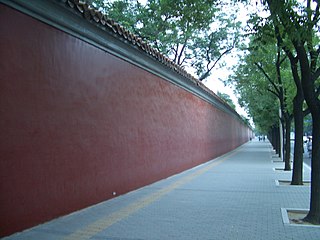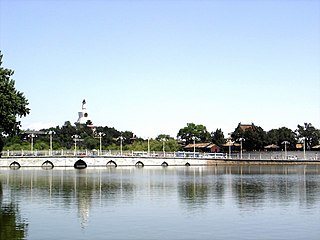Zhongnanhai
| Zhongnanhai | |
|---|---|
 Xinhuamen, the "Gate of New China", built by Yuan Shikai, today the formal entrance to the Zhongnanhai compound | |
 | |
| General information | |
| Architectural style | Traditional Chinese Architecture |
| Address | 174 Chang'an Avenue, Xicheng District, Beijing[1] |
| Coordinates | 39°54′41″N 116°22′50″E / 39.9113°N 116.3805°E |
| Current tenants | |
| Zhongnanhai | |||||||||||
|---|---|---|---|---|---|---|---|---|---|---|---|
| Chinese | |||||||||||
| Literal meaning | "Central and Southern Lakes" | ||||||||||
| |||||||||||


Zhongnanhai (Chinese:
The state leaders, including the president, general secretary of the CCP, and other top party and state leadership figures carry out many of their day-to-day administrative activities inside the compound, such as meetings with foreign dignitaries. China Central Television (CCTV) frequently shows footage of meetings inside the compound, but limits its coverage largely to views of the interior of buildings. Though numerous maps of the complex exist from before the founding of the People's Republic of China, the interior layout of Zhongnanhai has been altered significantly since then, including a wave of major renovations in the 1970s. Today many buildings share the names of older, pre-PRC structures, but have completely changed in layout and purpose. The complex is divided into two main sections, reflecting the parallel authority of the highest level of state and party institutions in the country. Northern Zhongnanhai is used as the headquarters of the State Council and includes the offices of its senior most leaders as well as its principal meeting rooms. Southern Zhongnanhai is the headquarters of the CCP Central Committee, including its staff and its highest level coordinating institutions, such as the Standing Committee, Politburo and Secretariat.
The current basic outline of Zhongnanhai emerged during the Ming dynasty when the Yongle Emperor began a project to subdivide and reclaim land around Taiye Lake in order to create a garden retreat. By the late Qing dynasty, Zhongnanhai was used as the de facto center of government, with Empress Dowager Cixi and later Prince Regent Chun building residences there instead of the Forbidden City. After the establishment of the Republic of China, the new president, Yuan Shikai remodeled Zhongnanhai to become the formal center of what would become known as the Beiyang Government. In 1949, CCP Chairman Mao Zedong moved into the complex after the establishment of the People's Republic of China. Mao received many important foreign leaders in Zhongnanhai, including Nikita Khrushchev, Che Guevara, Richard Nixon, Georges Pompidou, Kakuei Tanaka and Zulfikar Ali Bhutto, among others.[2][3] Mao's favorite places in Zhongnanhai were the Library of Chrysanthemum Fragrance (his personal residence, filled with bookshelves) and the Poolside House, next to the large indoor swimming pool, where he would spend much of the day swimming or reading books and reports by the pool. After Mao's death, the Chrysanthemum Library along with many of his belongings was preserved as a museum which is no longer accessible to the general public.
Location
[edit]

The name of the Zhongnanhai complex, immediately west of the Forbidden City, means "Central and Southern Seas" referring to two lakes, the Central Sea (
The Taiye Lake originally formed the core of an imperial garden called Western Park (Xiyuan;
History
[edit]
During the Jin dynasty (1115–1235), Emperor Zhangzong of Jin built the northern lake in 1189.[clarification needed] The northern section of Zhongnanhai was the original Taiye Lake,[citation needed] with an attached palace called the "Palace of Great Peace" (Daninggong). During the Yuan dynasty, which lasted from 1271 to 1368, Taiye Lake was included within the Imperial City. It was also expanded, covering approximately the area occupied by the Northern and Central Seas today. Three new palaces were built around the lake.[citation needed]
After the Ming dynasty moved its capital to Beijing in 1403 by order of the Yongle Emperor, construction of the now extant Imperial Palace began in 1406. The new Ming palace was built to the south of the Yuan dynastic palace, as a result, a new Southern Sea was dug to the south of the existing lake. The excavated soil, together with that from the construction of the palace moat, was piled up to form Jingshan, a hill to the north of the Forbidden City. At this time, the three lakes were connected through channels and collectively called the Taiye Lake,[1] part of the extensive royal park called Xiyuan (
After the Qing dynasty established its capital in Beijing, the government reduced the size of Xiyuan to the area centered around the three lakes enclosed by a small wall, portions of which form the basis of Zhongnanhai's current boundary. During the late Qing dynasty, several gatehouses were built on both sides of Jin'ao Yudong Bridge[Chinese Wikipedia], giving Zhongnanhai and Beihai Park separate wall enclosures within Xiyuan.[6] Several successive emperors built pavilions and houses along the lakeshores of Zhongnanhai, where they would carry out government duties in the summer. During the reign of the Empress Dowager Cixi, both the Empress Dowager and the Emperor would often live in the Zhongnanhai compound, traveling to the Forbidden City only for ceremonial duties.[citation needed]
During the Boxer Rebellion of 1899–1901, allied troops occupied Zhongnanhai. Almost all artifacts and decorations in the compound were looted. Later, the Eight-Nation Alliance commander also lived in Zhongnanhai. When Puyi was crowned Emperor, his father as the Prince Regent lived for a short time in the compound.[7]
Zhongnanhai continued to be politically significant during the first years of the Republic of China, as the Beiyang Government under Yuan Shikai placed its presidential palace in the Zhongnanhai compound from 1912. This decision was made because the regime wished to house its government close to the historical center of power, the Forbidden City, even though it could not use the Forbidden City itself because the abdicated Emperor Puyi still lived there. The current main gate, Xinhua Gate or "Gate of New China", was created by Yuan Shikai. The present "gatehouse" was previously a pavilion located on the southern shore the Southern Sea, close to the southern wall. Entry to the compound was instead directly from the Forbidden City. Yuan wished to create a new entrance from Chang'an Avenue, independent of the Forbidden City. Thus the pavilion was modified to become a gatehouse, with nearby walls cut back, resulting in the angled walls near the entrance today.[1] Yuan renamed Zhongnanhai Palace of the New China (Xinhua Palace, Chinese:
After the CCP's Capture of Beijing in 1949, the party's senior leadership began plans to relocate their headquarters to the old capital, but they did not initially agree on the location of their central workplace. Mao Zedong and the other party leaders initially made their headquarters at Xiangshan Park, in the city's suburbs.[citation needed] As part of the planning for the first Chinese People's Political Consultative Conference Zhou Enlai decided that, with some modifications, Huairen Hall in Zhongnanhai would be ideal, but he did not initially recommend it during meetings to become the party headquarters. In these early months, Zhou would commute into Beijing for work. However, because of the poor quality of the roads, he would often stay at Zhongnanhai instead of traveling home in the evening. It was Ye Jianying, the interim administrator of Beijing, who ultimately recommended Zhongnanhai as the party headquarters for security reasons. Mao Zedong initially refused to move into Zhongnanhai, not wanting to be equated with an emperor. Zhou Enlai nonetheless agreed to the move, as did the majority of the Politburo. Since then, Zhongnanhai has served as the principal center of government in the People's Republic of China.[9][10]
When the CCP leaders first moved into the compound, many of the buildings were dilapidated and gardens overgrown from years of neglect. Zhongnanhai also lacked either a modern administrative office complex or a purpose-built auditorium for government meetings. These deficiencies prompted the construction of West Building compound and the complete remodeling of Huairen Hall by 1954, along with numerous other architectural changes. Early party and state laters were assigned residences in Zhongnanhai on an ad hoc basis, often using houses built for servants of the Qing court, or by repurposing buildings intended for other purposes.
In contemporary times
[edit]
Since Zhongnanhai became the central government compound, it has been mostly inaccessible to the general public. The exception to this was during the years of relative freedom following the end of the Cultural Revolution, when the compound was open to members of the public, who could obtain tickets to visit the compound from relevant government authorities. Following the political turmoil that culminated in the 1989 Tiananmen Square protests and massacre, security was greatly increased. Access has now been closed to the general public, with numerous plain clothed military personnel patrolling the area on foot. However, cars are not strictly prohibited from stopping on stretches of adjacent roadway and cabs are allowed to stop except during important conferences or events.[11] Chinese maps of Beijing show Zhongnanhai as an insignificant green area with a water body; in contrast, the municipal government, however, is shown significantly with a red star.
The most important entrance to the compound is the southern one at Xinhuamen (Xinhua Gate, or "Gate of New China"), surrounded by two slogans: "long live the great Chinese Communist Party" and "long live the invincible Mao Zedong Thought." The view behind the entrance is shielded by a traditional screen wall with the slogan "Serve the People", written in the handwriting of Mao Zedong. The Xinhuamen entrance lies on the north side of West Chang'an Avenue.[1]
Zhongnanhai is considered the de jure residence of the CCP Politburo Standing Committee members and other senior leaders for electoral purposes.[12] Though it serves as their formal residence, many senior party leaders do not actually live in Zhongnanhai, preferring to live in homes elsewhere in the city.[11] Several more recent leaders, such as then General Secretary and paramount leader Hu Jintao reportedly chose to live in the Jade Spring Hill compound in western Beijing due to overcrowding inside Zhongnanhai.[13] China's current leader Xi Jinping also has a home in Jade Spring Hill.[14] There continues to be no standardized system for awarding certain houses to leaders of a certain rank in Zhongnanhai. After a senior leader's death, their spouse is often permitted to stay in the house indefinitely.[15] Several of these houses were occupied by the families of their original post-revolution residents into the 1990s.
-
Late 18th-century painting showing the reception for the victorious Qing Army from the Jinchuan campaign (1771–1776) at the Hall of Purple Light in Zhongnanhai
-
The Empress Dowager Cixi and servants on a boat in Zhonghai in the early 1900s.
-
Procession of Leo Karakhan, USSR Ambassador to China 1923–26, outside the Xinhua Gate of Zhongnanhai.
-
Leaders of the People's Republic, from left, Zhu De, Mao Zedong, Chen Yun and Zhou Enlai outside the Hall of Purple Light (Ziguangge) in 1954.
-
Chinese leader Hu Jintao with U.S. President George W. Bush and former U.S. President George H. W. Bush in at Yingtai in Zhongnanhai on August 10, 2008.
Internal layout
[edit]| An annotated map of Zhongnanhai. Click on the links for more information about each building. |
Central Sea
[edit]The buildings around the Central Sea (Chinese:
Regent Palace
[edit]The original Regent Palace (
During the Ming dynasty, the Jiajing Emperor built Wanshou Palace in this area as his main living palace within Zhongnanhai. Nothing remained of this palace by the late Qing era, however. The building that came to be known as Regent Palace took its name from Puyi's regent Zaifeng, Prince Chun. Prince Chun was given the land to build his palace here in 1909, though the building was not completed by the time the Qing dynasty ended in 1911. Under the Republic of China, the building was initially the location of the prime minister's office and the meeting place of the cabinet. In 1918, President Xu Shichang switched the president's residence and the prime minister's office, relocating his residence to Regent Palace, while the prime minister and Cabinet moved to Dianxu Hall in the Garden of Abundant Beneficence.[21] When Huairen Hall became the Presidential residence in 1923, Regent Palace became the location of the army and naval department.
After 1949, the People's Republic of China again used the building as the headquarters of the premier and the State Council. Though the building was beginning to show its age at the time, initially Premier Zhou Enlai resisted renovation efforts citing a commitment to fiscal austerity. During a massive renovation of Zhongnanhai in the late 1970s, plans were made to modernize Regent palace as well. It was found, however, that the quality of the building was very poor, the foundations were loose and the gaps between the wooden columns were filled with broken bricks. As a result, the upper and entrance halls were torn down and rebuilt completely. The location where these halls once stood is currently the location of several of the State Council's conference rooms.[22]
West Flower Hall
[edit]
Located in the northwestern corner of Zhongnanhai, West Flower Hall (
During the large scale demolition and redevelopment of Regent Palace, Wang Dongxing built a large house adjacent to both West and East Flower Halls for Paramount Leader Hua Guofeng. When Hua Guofeng was forced from power, he exchanged this house with Li Xiannian and moved to Li Xiannian's temporary residence outside of Zhongnanhai. Li Xiannian and his family subsequently lived here through his presidency until his death, after which, his wife Lin Jiamei continued to occupy the residence. In 1996, Li Peng attempted to claim West Flower Hall as his post premiership residence. Li Peng was motivated in part by the relationship he had with Zhou Enlai and Deng Yingchao as their foster son. Li Peng's efforts were unsuccessful, however, and West Flower Hall subsequently became part of the North Courtyard Core (
Premier's Office
[edit]The modern workplace of the premier and the vice premiers of the State Council, the Premier's Office (总理办公
Fourth Conference Room
[edit]The Fourth Conference Room (
Ziguang Hall
[edit]
Literally translated as Hall of Purple Light (Ziguangge;
The State Council Auditorium (
Immediately adjacent to Ziguang Hall are a variety of other institutions and facilities such as the State Council Research Office and the Zhongnanhai north district's canteen.[36][37][28] Between 2003 and 2013, there was also a roughly 300-square-meter supermarket store belonging to the Sichuan-based Hongqi chain located near Ziguang Hall.[38]
Tennis Court
[edit]Initial plans to build an indoor tennis court in the State Council section of Zhongnanhai were made in the late 1980s. At the time China was receiving a significant influx of new diplomatic delegations on international exchange trips. Feeling that the facilities for hosting these diplomats at Ziguang Hall at the time were inadequate, some officials proposed that a guest lounge and tennis court be built nearby. The proposal for an indoor tennis court was, at the time, vetoed by Vice Premier Tian Jiyun.[39] In spite of this initial resistance, an outdoor tennis court was built in Zhongnanhai by the early 2000s.[40] In 2006, the building around the tennis court was rebuilt and modernized.[41] Immediately to the north of the tennis court is the Zhongnanhai clinic.[42]
Indoor Pool
[edit]An indoor swimming pool was built in 1955 by the Urban Construction and Design Institute. Mao Zedong's wife Jiang Qing reportedly proposed the building's construction during Mao's absence in order to secure its approval. Mao nonetheless used the pool because it was more convenient than traveling to the pool at Tsinghua University. Mao often stayed and worked at the pool for long periods of time. In 1958, Mao met with Soviet General Secretary Nikita Khrushchev at the pool. During the time when Mao lived nearby at Poolside House, the indoor swimming pool was remodeled and enlarged under the supervision of Zhongnanhai's head engineer Tian Genggui. Today the pool is used by senior party leaders and also contains a workout area.[43]
Poolside House
[edit]The Zhongnanhai outdoor swimming pool was built in 1933 as a public–private partnership when Zhongnanhai was a public park. Tickets were sold to Beijing citizens each year from May to August. From 1946 to 1949, it was difficult to operate the pool profitably due to high inflation. After Zhongnanhai was taken over for the exclusive use of the government, a poolside house was built next to the swimming pool as a residence for Mao Zedong. It was initially built for practical reasons, as Mao would frequently spend much of the day either swimming in the pool or reading political and historical books and reports from government officials by the pool's side. Therefore, a reception room, a bedroom and a study with Mao's favorite books were built, thus creating the Poolside House which allowed Mao to be permanently close to the swimming pool.[44] Eventually, among Zhongnanhai staff, the phrase "you are wanted at the swimming pool" meant that they were ordered to immediately report to Mao.[44]
Mao permanently left the Chrysanthemum Library and moved into the Poolside House in 1966, at the beginning of the Cultural Revolution. Especially in his later years, the Poolside House would be the place for visiting foreign leaders to see Mao. This was the case for Richard Nixon and Kakuei Tanaka.[44] After Mao's death in 1976, Zhou Enlai's wife Deng Yingchao briefly lived at poolside house during the extensive redevelopment of the Regent Palace area before returning to West Flower Hall.[45] During the 1989 Tiananmen Square Protests, President Yang Shangkun moved into Zhongnanhai and lived at Poolside House due to security concerns created by the protesters.[46]
Yanqing House
[edit]Yanqing House (
Wan Shan Temple
[edit]Also known in English[citation needed] as Thousand Benevolence Hall (
Water Clouds Pavilion
[edit]Located on an island in the Central Sea, the Water Clouds Pavilion contains a stele engraved by the Qianlong Emperor reading "Autumn Wind on the Taiye Lake".[1]
Southern Sea
[edit]The Southern Sea (Nanhai,
Huairen Hall
[edit]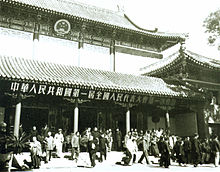
Huairen Hall (怀仁
The building served as the daily workplace of Dowager Empress Cixi, the then de facto ruler of China, replacing the Hall of Mental Cultivation in the nearby Forbidden City. After the Boxer rebellion, Huairen Hall became the headquarters of the occupying Eight Nation Alliance's commander Alfred von Waldersee until the building was damaged in a fire. In 1902 Empress Cixi rebuilt Huairen Hall at a cost of five million taels of silver before ultimately dying here in 1908.[53] After the founding of the Republic of China in 1911, President Yuan Shikai used the building to meet with foreign guests and to accept New Year's day greetings. After Yuan's death, it was the site of his funeral. When Cao Kun became president, he used Huairen Hall as his residence. After the end of the Beiyang Government Huairen Hall had no permanent use and was given to the Beijing City Government.[8]
After the founding of the People's Republic of China, the first plenary session of the Chinese People's Political Consultative Conference (CPPCC) was held in Huairen Hall in September 1949. In order to serve as an audience hall for the CPPCC, an iron sheet roof was built over one of the building's courtyards. In 1952, this roof was replaced with a more permanent two-story auditorium in preparation for the Asia-Pacific Peace Conference.[54][55] The new meeting hall was then used for first session of the National People's Congress in 1954.[56] Huairen Hall became the auditorium of the central government, often hosting various art shows and political meetings, including Central Committee plenums before the construction of Jingxi Hotel in 1964.[57]
Qinzheng Hall
[edit]
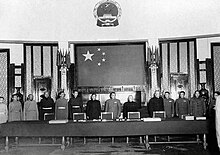
Qinzheng Hall (
The general secretary's personal office is located behind an office which, in the 1980s, served as workplace of his policy secretary. The office of the policy secretary was occupied by Secretary Bao Tong at the time, and the position and staff associated with it have since been more formalized as the Office of the General Secretary. The policy secretary's office is, in turn, behind another office which served as a workplace for the director of the Central Committee's General Office.[64] It is partially because the head of the General Office has a workplace in front of the office suite of the general secretary that the director's position is referred to as the "Danei Zongguan" (
In addition to the General Secretary's suite, Qinzheng Hall is also the location of the offices for all of Secretaries of the Secretariat, including the First Secretary of the Secretariat, who has de facto responsibility for the secretariat's day-to-day administration of the party.[66] Each secretarial suite in Qinzheng Hall has a space for receiving guests and a space for working. The General Secretary's suite is comparatively larger and has the most complete facilities in the building, including a sleeping space so that the General Secretary does not need to return to his residence when working for long periods of time.[67] There is an encrypted hotline that runs from Qinzheng Hall to the White House in Washington, D.C. for the purpose of conducting high level talks with American leaders.[68]
The original Qinzheng hall was built by the Kangxi Emperor as the main hall of the Zhongnanhai complex, serving as the Emperor's primary living and working space in Zhongnanhai.[69] After the 1911 revolution, the building served as a venue for government conferences during both the Republic of China and the People's Republic of China. Qinzheng Hall served as the meeting place for the Central People's Government Committee, the interim council that governed China from 1949 until the promulgation of the 1954 Constitution.[70] While serving as the headquarters of the Central People's Government, Qinzheng hall was the site of the 1951 Seventeen Points Agreement which established the terms under which Tibet would come under the sovereignty of the People's Republic of China.[71] In the late 1970s, Wang Dongxing, the director of the Central Committee General Office, demolished Qinzheng hall and spent 6.9 million yuan intended for its reconstruction to build his own private residence. Wang's removal as head of the Central Committee General Office in 1978 prevented him from completing his plan. Ultimately, the rebuilt Qinzheng hall was inaugurated as the Secretariat's new headquarters in March 1980.[58]
Benevolence Hall
[edit]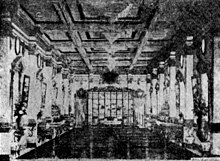
The former Benevolence Hall (
After 1949, the building served as the first headquarters of the Central Military Commission (CMC) before the CMC staff relocated outside of Zhongnanhai. In 1956, the CCP Secretariat became an institution separate from the staff of the party chairman and required its own headquarters. The new general secretary, Deng Xiaoping, chose Benevolence Hall to house the Secretariat. During this period, the building did not undergo any significant maintenance and was finally deemed unsafe and demolished in 1964. The Secretariat offices temporarily moved to "Building C" in the West Building Compound before moving to Qinzheng Hall in 1980.[72] The former location of Benevolence Hall is currently an open park area.
Four Blessing Halls
[edit]The Four Blessing Halls (
West Building Compound
[edit]The complex of buildings known as West Building Compound (

After West Building was constructed, the complex became the site of the offices of the State Chairman, Premier and all state Vice Chairmen under the Common Program who were also Communist Party members. When the positions of the State Chairman and Chairman of the Communist Party were separated in 1959 and Liu Shaoqi assumed the State Chairmanship, the State Chairman's workplace continued to be located in West Building. During this time, Liu Shaoqi's office was located in Building A.[79][80] Likewise, Marshal Zhu De's office remained in Building B of the West Building compound when he served as singular state Vice Chairman under the 1954 Constitution.[81] In 1962, President Liu Shaoqi presided over an extraordinary, enlarged meeting of the Politburo Standing Committee in this location, known as the "West Building Meeting". At the meeting, the party leaders discussed in significant detail the dire fiscal and economic situation in the country in the aftermath of the failure of the Great Leap Forward and promised to recover the agricultural sector.[82]
Between 2007 and 2008, part of the original West Building Compound was demolished to make way for a new three-story rectangular building that was completed by 2010.[83] The Central Committee General Office's physical office footprint has now expanded beyond Zhongnanhai to include several buildings on the other side of Fuyou Street from West Building as well as other buildings in the Xicheng District area.[84] The gate on Fuyou Street that Central Committee staff use to travel between buildings inside and outside of the complex is called the "Great West Gate" because it has the highest regular use of Zhongnanhai's gates.[85]
Many of the agencies directly under the supervision of the Central Committee General Office now have their formal headquarters in an annex of buildings spread out on the western side of Fuyou Street adjacent to Zhongnanhai as well as certain locations still within southern Zhongnanhai. The formal addresses of these agencies are as follows:
- Research Office: 8 Fuyou Street, Xicheng District, Beijing
- Secretary Bureau: 1 Boxue Hutong, Xicheng District, Beijing
- Bureau of Regulations: 99 Fuyou Street, Xicheng District, Beijing
- Security Bureau: 81 Nanchang Street, Xicheng District, Beijing (Shuqingyuan Pavilion)
- Confidential Bureau: 7 Dianchang Road, Fengtai District, Beijing
- Confidential Transportation Bureau: 11 Xihuangchenggen North Street, Xicheng District, Beijing
- Special Accounting Office: 14 Fuyou Street, Xicheng District, Beijing
- Supervision and Inspection Office: Unknown location, Beijing
- Personnel Bureau: 12 Fuyou Street, Xicheng District, Beijing (West Building Compound proper)
- Office of the General Secretary: Qinzheng Hall, Xicheng District, Beijing
- Veterans Bureau: 50 Dajue Hutong, Xicheng District, Beijing
- Administration Bureau of Organs directly under the Central Committee: 9 Xihuangchenggen North Street, Xicheng District, Beijing
Garden of Abundant Beneficence
[edit]
Some of the buildings within the Garden of Abundant Beneficence (丰泽园;
The largest building in the Garden of Abundant Beneficence is Dianxu Hall, which was known as Chong Ya Temple during the Qianlong Emperor's reign, Yinian Temple (頤年
The Garden of Abundant Beneficence also contains Chairman Mao Zedong's first personal residence and office, which he used from 1949 to 1966, a building called the Library of Chrysanthemum Fragrance (
Shuqingyuan Pavilion
[edit]Located in the northeastern corner of the Southern Sea, the Shuqingyuan Pavilion (
Building 202
[edit]The building (202别墅) next to Huairen Hall was constructed in 1974 as a specially reinforced earthquake shelter.[96] Before the current building was built on this location, the area to the east of Huairen Hall was the site of the homes of Dong Biwu and Chen Boda.[97] Mao Zedong was relocated to Building 202 from Poolside House after the July 1976 Tangshan earthquake. Mao died in this building on September 9, 1976.[98][42] During the 1989 Tiananmen Square Protests, Premier Li Peng moved into Zhongnanhai and lived in Building 202 due to the perception that he was vulnerable to attack at his residence at Wanshou Road.[46][99]
Western Four Houses
[edit]The Four Western Houses (
Wanzi Gallery
[edit]The original buildings in the area of Wanzi Gallery (
During his presidency, Liu Shaoqi moved to a building in this area called Fuluju (
Yingtai Island
[edit]
Located in the Southern Sea, the artificial Yingtai Island (瀛台; 瀛臺) was completed in 1421 by Ming Emperor Yongle after he relocated his capital to Beijing. The island was given its current name by Qing Emperor Shunzhi in 1655. Yingtai Island is connected with the shore via a stone bridge. Due to a slope of elevation on the island, the main temple in the north is a single-story building while in the south there exists a two-story pavilion called Penglai Pavilion. There are two temples to the north of Hanyuan Temple, Qingyun Temple to the east and Jingxing Temple to the west. In July 1681, the Kangxi Emperor held the "Yingtai hearings" on the development of a national strategy to put down civil strife. Dowager Empress Cixi imprisoned Emperor Guangxu at Hanyuan Temple on Yingtai in August 1898 after the failure of the Hundred Days Reform. Emperor Guangxu was subsequently poisoned and died here in 1908.[citation needed]
Since 1949, Yingtai is used as the site of banquets and other hospitality activities.[107] According to some sources, Jiang Zemin lived in Hanyuan Temple on Yingtai Island during his time as paramount leader.[108]
Xinhua Gate
[edit]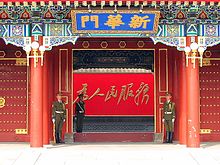
Zhongnanhai's main entrance, the Xinhua Gate (
Gallery
[edit]-
Office buildings in the State Council area of Zhongnanhai[109]
-
The western wall of the Zhongnanhai compound and Imperial City of Beijing
-
Road inside Zhongnanhai
-
From the central part of Zhongnanhai across the Middle Sea, to the bridge that divides Zhongnanhai from Beihai Park, with the White Stupa of the Beihai Park seen in the distance
See also
[edit]- Beidaihe District
- Diaoyutai State Guesthouse
- History of Beijing
- Imperial City, Beijing
- Beihai Park
- Summer Palace
- Old Summer Palace
- Jade Spring Hill
- Presidential Palace, Nanjing
References
[edit]- ^ a b c d e f g "Zhongnanhai – the Political Center of China". travelchinaguide.com. TravelChinaGuide. Archived from the original on 15 April 2015. Retrieved 7 February 2018.
- ^ Woodrow Wilson International Center for Scholars (2015). Fardella, Enrico; Ostermann, Christian F.; Kraus, Charles (eds.). Sino-European Relations During the Cold War and The Rise of a Multipolar World: A Critical Oral History (PDF). Washington, DC: Wilson Center. ISBN 978-1-938027-98-7. Archived from the original (PDF) on 22 June 2019.
- ^ French Presidents' China complex Archived 2019-06-25 at the Wayback Machine People's Daily Online
- ^ "Zhongnanhai (Central and South Lakes)". china.org.cn. China Internet Information Center. Archived from the original on 27 April 2006. Retrieved 27 February 2018.
- ^ Li, Genli. "
西 苑 与 明朝 那 些事 儿". Beijing Daily. Retrieved 17 March 2024. - ^ Luo, Dongsheng. "
昔日 御苑 里 的 金 鳌玉蝀桥是 如何 变成今 天 的 北海 大 桥的". Beijing Daily. Retrieved 17 March 2024. - ^ a b "
随 历史远去的中 南海 居 仁 堂 ".随 历史远去的中 南海 居 仁 堂 . Phoenix New Media Limited. Archived from the original on 2 July 2019. Retrieved 8 February 2018. - ^ a b http://www.25dx.com/beijing/2006/200607/2006-07-09/206729.html[permanent dead link]
- ^ "揭党
中央 搬进中 南海 往事 :毛 泽东为何不 愿 意 进中南海 ". book.people.com.cn/. Archived from the original on 16 January 2020. Retrieved 19 May 2020. - ^ "
毛 泽东曾拒绝入住 中 南海 :"我 不 搬,我 不 做皇帝 "". history.people.com.cn/. Archived from the original on 4 April 2013. Retrieved 19 May 2020. - ^ a b c Kristof, Nicholas (January 25, 1991). "Beijing Journal; Whatever the High Walls Hide, It Isn't Opulence". The New York Times. Archived from the original on 8 February 2018. Retrieved 7 February 2018.
- ^ "Chinese leaders vote in local elections". People's Daily. people.cn. November 9, 2006. Archived from the original on 1 March 2018. Retrieved 1 March 2018.
- ^ "罗冰:
江 泽民抓 到 胡 锦涛甚么把 柄 ". duping.net. The Independent Review. Archived from the original on 9 February 2018. Retrieved 9 February 2018. - ^ "Beijing Police Detain Hundreds For Trying to Visit Chinese Leaders Over New Year". Broadcasting Board of Governors. Radio Free Asia. 2015-02-20. Archived from the original on 2018-03-01. Retrieved 1 March 2018.
- ^ Wang, Dongya. "
文 汪 东亚". NetEase Inc. Archived from the original on 2018-02-10. Retrieved 10 February 2018. - ^ a b "
程 晓农:习近平 重 建 "军机处"". Radio Free Asia. Retrieved 12 May 2024. - ^ Schell, Orville (9 January 2001). The Tiananmen Papers - The Chinese Leadership's Decision To Use Force Against Their Own People - in Their Own Words. New York: PublicAffairs. p. 10. ISBN 978-1586480127. Retrieved 11 May 2024.
- ^ a b "
北京 国 务院有 几个会 议室?内 鬼 在 哪个会 议室?(组图)". wenxuecity.com. wenxuecity.com. 2017-07-04. Archived from the original on 2018-02-23. Retrieved 22 February 2018. - ^ Wu, Guoguang. "吴国
光 :赵紫阳的风格、关怀与胸襟 ". www.chinesepen.org. Independent Chinese PEN Center. Archived from the original on 27 September 2018. Retrieved 18 May 2024. - ^ "
李 克 强 :政府 说到就要做到,决不能 放 空 炮". newyork.china-consulate.gov.cn. Consulate General of the People's Republic of China in New York. Retrieved 18 May 2024. - ^ Zhen, Jiang. "袁世凯做
洪 宪梦 冯国璋 发卖鱼财变幻大王 旗 的 总统府 ". xueshu.com. Archived from the original on 2018-02-12. Retrieved 11 February 2018. - ^ Wu, Kong. "
醇 亲王府 的 三 次 迁建". Ziguangge (1995). Retrieved 19 November 2022. - ^ Xia, Jie. "
接收 中 南海 亲历记". ggj.gov.cn. Office of the State Administration of Institutional Affairs. Retrieved 7 May 2024. - ^ "
在国 务院总理值班室 工作 的 年代 ". natcm.gov.cn. National Administration of Traditional Chinese Medicine. Retrieved 9 May 2024. - ^ Zong, Hairen. "
中 南海 分 房子 叫 人 哭笑不 得 ——回 忆朱熔基在 1999年 ". cnd.org. Archived from the original on 18 November 2022. Retrieved 18 November 2022. - ^ "习近
平 怎么办?中 南海 惊现钉子户". news.creaders.net. CyberMedia Network/Creaders.NET. Retrieved 18 November 2022. - ^ "
原 港 区 人 大 代表 吴康民 获温总理会 见称 气氛轻松". chinanews.com. Archived from the original on 2022-10-23. Retrieved 23 October 2022. - ^ a b "总理
吃 中 餐也要 排 队走 进神秘 的中 南海 (组图)". wenxuecity.com. 2005-09-01. Archived from the original on 2018-02-17. Retrieved 16 February 2018. - ^ "General Office of the State Council". google.com/maps. Archived from the original on 24 May 2022. Retrieved 4 March 2018.
- ^ "
中 南海 总理会 议室". Action Time.北京 星 启邦威 电子有限 公司 . Retrieved 19 November 2022. - ^ "
中 南海 舞 会 见闻:毛 主席 跳 舞 踩不到 点 ". People's Daily. People's Network. 2011-03-01. Archived from the original on 2018-09-18. Retrieved 12 February 2018. - ^ "
中 南海 照 片 首 次 曝光,太 难得一 见,赶紧看 !". aixincb.com. Archived from the original on 24 May 2022. Retrieved 19 May 2020. - ^ "
中 南海 里 的 建 筑也曾遭"拆迁"". sohu.com. Archived from the original on 8 February 2018. Retrieved 7 February 2018. - ^ "领导
人 在中 南海 里 的 生活 :在 小 礼 堂 看 电影要 买票". CNR. Archived from the original on 2019-06-07. Retrieved 17 November 2022. - ^ "
李 强 主持 召开国 务院第 一 次 全体 会 议". gov.cn. China Government Network. Retrieved 15 May 2024. - ^ Feng, Lanrui. "冯兰
瑞 :在国 务院政治 研究 室 的 日子 ". reformdata.org. China (Hainan) Reform and Development Research Institute. Retrieved 15 May 2024. - ^ "
国 研 斯坦福 走 进中南海 ". edpsp.com. Executive Development Programs Service Platform. Archived from the original on 21 September 2022. Retrieved 16 August 2022. - ^ "
中 南海 内 唯一 超 市 经营10年 后 关门 员工拒 透 露 原因 ". people.com.cn. Retrieved 17 March 2024. - ^ Zhao, Qingyun. "
老 干 部 忆80年代 中 南海 :国 务院配 车是淘汰 车型". news.ifeng.com. Phoenix New Media Limited. Archived from the original on 2011-02-07. Retrieved 19 May 2020. - ^ Zhu, Xiaoping. "万里的体育情怀". chinaqw.com. Archived from the original on 24 May 2022. Retrieved 19 May 2020.
- ^ "Historical data from Google Earth". Google Earth. Archived from the original on 24 May 2022. Retrieved 19 May 2020.
Data from April 2006
- ^ a b "Introduction to Zhongnanhai CP Leadership Compound Schematic Map 02". drben.net. ChinaReport.com. Archived from the original on 8 February 2018. Retrieved 7 February 2018.
- ^ "
游泳 池 卫生间…如何 修 缮中南海 内 毛 泽东住所 ". People's Daily. People's Network. Archived from the original on 8 February 2018. Retrieved 7 February 2018. - ^ a b c Dr. Li Zhisui, The Private Life of Chairman Mao, II: 1949–1957, 5, Random House, (1994)
- ^ "
中 南海 内 修 缮工程 杂忆". People's Daily. Archived from the original on 20 February 2017. Retrieved 7 February 2018. - ^ a b Xu, Jiatun (1993).
許 家 屯 香港 回 憶錄. Hong Kong: Hong Kong United News Co., Ltd. Retrieved 5 May 2024. - ^ a b Xiao, Yifei. ""
夏 都 "旧 闻——胡 、梁 保 护古建 筑事迹考". xsg.tsinghua.edu. Tsinghua University History Museum. Retrieved 30 April 2024. - ^ Xia, Jie. "
北平 解放 ,接收 人 员是怎样清 理 中 南海 的 "老 住 户"的 ?". Wenhui. "Century Tide"--Official website of the Central Research Institute of Party History and Literature. Retrieved 5 May 2024. - ^ Wang, Jun (15 June 2013). "
中央 政治 局 如何 开会". qikan.com. Archived from the original on 10 February 2018. Retrieved 18 October 2017. - ^ ""怀仁
堂 政 变"后 的 政治 局 紧急会 议". DWnews.com. Deutsche Welle. Archived from the original on 2018-02-06. Retrieved 5 February 2018. - ^ Chen, Zhu Qin (2014-06-19). "习近
平 主持 中央 财经领导小 组会议,还有谁在座 ?". Shanghai Oriental Press Co. The Paper. Archived from the original on 2020-10-30. Retrieved 11 February 2018. - ^ "
全面 深化 改革 领导小 组会议部分 参会 人 员名单". eastday.com. 23 January 2014. Archived from the original on 30 October 2020. Retrieved 6 March 2018. - ^
陶 无梦·《春 冰室野乘 》:佛 照 楼 即 仪銮殿 旧址 。殿 毁于庚 子 之 乱 ,回 銮后重 修 ,费帑五 百 余 万 。 - ^ npc.gov.cn. "
行 进中的 程 序 民主 ". 《中国人 大 》杂志社 . Retrieved 15 March 2024. - ^ 刘宁
一 ·《周 恩来 与 建国 前 后 的 人民 外交 》:“恩来 同志 亲自制定 了 改造 怀仁堂 的 方案 ,把 原 来 仅能容 纳300多 人的 一个四合院改建成能容900人 的 大礼 堂 。” - ^ "
第 一屆全國人民代表大會和中華人民共和國憲法的制定". People's Daily. People's Network. Archived from the original on 25 February 2018. Retrieved 25 February 2018. - ^ "
中共 第 八 届 历次中央 全会 ". gov.cn. Archived from the original on 26 February 2018. Retrieved 25 February 2018. - ^ a b "
文革 后 的中 南海 :中央 办事效率 最高 的 时期". Comsenz Inc. Archived from the original on 2018-02-08. Retrieved 7 February 2018.. - ^ 瀚雅
画廊 . "天道 酬 勤 绘沧桑 ——著名 山水 画家 张登堂 ". gallery.artron.net. Archived from the original on 10 December 2018. Retrieved 10 December 2018. - ^ "赵紫阳:5月17
日 决定六 四 悲剧李 鹏日志 :邓小平 提 戒严令 ". backchina.com. Overseas Chinese. Archived from the original on 10 February 2018. Retrieved 9 February 2018. - ^ "
胡耀邦 在中 南海 勤 政 殿 小 会 议室与 青年 人 座 谈时的 讲话". China Reform Information Database. Archived from the original on 24 June 2021. Retrieved 19 June 2021. - ^ Li, Peng. "决定
中国 命 运的一 次 会 议". bannedbook.org. Retrieved 19 November 2022. - ^ Zhang, Hongzun. "张宏遵:
大悲 无泪祭 耀邦". aisixiang.com. Retrieved 19 November 2022. - ^
李 南央 . "鲍彤再 看 六 四 (二 ):我 是 如何 被 抓 进秦城 的 ". The New York Times. Archived from the original on 10 December 2018. Retrieved 10 December 2018. - ^ Wu, Ting. "「
大内 总管」栗 战书的 隐祕使命 ". dwnews.com. Archived from the original on 24 June 2021. Retrieved 16 June 2021. - ^ Ta, Kung Pao. "曾庆红
三 次 拥抱,谢幕退出 政 坛". boxun.com. Archived from the original on 23 September 2020. Retrieved 21 May 2020. - ^ "
夜 话中南海 :中共 十 四大前江泽民不堪回首的"儿皇帝 "经历". Radio Free Asia. Archived from the original on 2022-12-13. Retrieved 27 April 2024. - ^ "
解 密 红色电话:"一 号 机 "没 有 拨号盘和加 密 按键". Phoenix New Media Limited. ifeng.com. January 13, 2014. Archived from the original on 4 February 2020. Retrieved 9 February 2018. - ^ "
中 南海 勤 政 殿 见证特殊 友 谊". qd8.com.cn. Archived from the original on 9 August 2018. Retrieved 12 February 2018. - ^ "1949
年 10月 1日 中央 人民 政府 委 员会举行第 一 次 会 议". People's Daily. People's Network. Archived from the original on 10 October 2015. Retrieved 25 February 2018. - ^ Akiner, Shirin (1996). Resistance and Reform in Tibet. Motilal Banarsidass Publishers. ISBN 9788120813717. Archived from the original on 24 May 2022. Retrieved 24 May 2020 – via Google Books.
- ^ Wu, Han. "百年烟云居仁堂". Archived from the original on 16 June 2018. Retrieved 8 February 2018.
- ^ Ye, Yonglie. "
叶 永 烈 :关于田家 英之 死 ". China Digital Times. Retrieved 5 May 2024. - ^ "彭德怀离开中
南海 "永福 堂 "全 过程". Netease. Retrieved 23 April 2023. - ^ "
中央 顾问委 员会:曾发挥积极作用 从成立 到 撤销历经十 年 ". people.com.cn. Retrieved 17 March 2024. - ^ "
中 顧委工作 紀 實 (1982–1987)". books.com.tw. Blog Lai Digital Technology Co., Ltd. Retrieved 23 April 2023. - ^ "Ashes of Jiang Zemin scattered into the sea". XinhuaNet. Retrieved 23 April 2023.
- ^ "readers365.com".
第 一篇在爷爷奶奶身边长大. Archived from the original on 2018-02-09. Retrieved 9 February 2018. - ^ "
毛 泽东指 责哪位 高 干 "荒淫 "". qq.com. Tencent. Archived from the original on 8 February 2018. Retrieved 7 February 2018. - ^ a b "
元 勋的红墙生活 :三年困难时期中南海里捞鱼吃(图)". chinanews.com. Archived from the original on 11 October 2013. Retrieved 19 May 2020. - ^ Tian, Baojun. "
建国 后 朱 德 元 帅的住 房 :还不如苏联集体 农庄主席 ". Phoenix New Media Limited. ifeng.com. Archived from the original on 16 February 2018. Retrieved 17 February 2018. - ^ "
西 楼 会 议(1962年 2月 21日 -23日 )". People. Archived from the original on 2018-08-02. Retrieved 19 May 2020. - ^ "Historical data from Google Earth". Google Earth. Archived from the original on 24 May 2022. Retrieved 19 May 2020.
Data from February 2007, May 2008 and May 2010
- ^ "2015
年 中央 办公厅遴选公务员面 试公告 ". chinagwy.org. Archived from the original on 19 February 2019. Retrieved 19 May 2020. - ^
王 凡:中 南海 西 楼 刘少奇 一 家人 的 平民 生活 . difangwenge.org. Archived from the original on 24 May 2022. Retrieved 20 May 2020. - ^ Dr. Li Zhisui, The Private Life of Chairman Mao, II: 1949–1957, 6, Random House, (1994)
- ^ "
上海 工 美 2015年 春 拍 呈 现项圣谟《临韩滉五 牛 图》". news.artron.net. Yachang Art Network. Archived from the original on 24 May 2022. Retrieved 19 May 2020. - ^ "《
春 耦斋》御 玺及"春 耦斋"往事 ". 99ys.com. Archived from the original on 5 April 2015. Retrieved 19 May 2020. - ^ "
震 惊披露 ,元 勋们的 红墙内 生活 !". freewechat.com. Archived from the original on 24 May 2022. Retrieved 19 May 2020. - ^ Chen, Huan. "
深 情 的 回 忆 ——瞻仰中 南海 毛 泽东故 居所 想起 的 往事 ". chinaqw.com. Archived from the original on 4 November 2021. Retrieved 19 May 2020. - ^ Wu, Lengxi. "忆毛
主席 ". ziwushuwu.com. Workers' and Peasants' World. Retrieved 6 August 2022. - ^ Liang, Changjun. "
毛 泽东初 进中南海 时的生活 ". news.ifeng.com. Phoenix New Media Limited. Retrieved 18 May 2024. - ^ "
毛 泽东与防空 洞 之 缘". skabag.com. Archived from the original on 9 October 2020. Retrieved 4 October 2020. - ^ Qi, Benyu. "
第 一 章 初 进中南海 ,任 政 秘 室 见习秘 书". marxists.org. Archived from the original on 16 August 2021. Retrieved 21 May 2020. - ^ "揭秘
中国 最 神秘 的 禁 地 ——中 南海 ". Sina Corp. Archived from the original on 20 April 2021. Retrieved 19 May 2020. - ^ a b "
毛 泽东与中 南海 :人生 最 后 十年在游泳池度过【3】". People's Daily. People's Network. Archived from the original on 24 January 2020. Retrieved 7 February 2018. - ^ a b Xu, Suizhi. "
己 所 不 欲 勿施于人——陈小鲁口述 ". cnd.org. China News Digest International. Retrieved 28 April 2024. - ^ Terrill, Ross (August 2010).
毛 泽东传. Renmin University of China. Archived from the original on 3 February 2018. Retrieved 7 February 2018. - ^ Li, Peng (1 January 2010). Li Peng Diary: The Critical Moments. Au Ya Publishing. ISBN 978-1921815003. Retrieved 5 May 2024.
- ^ "苏秉琦的
六 十 年 考古 人生 ". mjlsh.usc.cuhk.edu.hk/. Chinese University of Hong Kong. Archived from the original on 8 February 2018. Retrieved 8 February 2018. - ^ Zuoliang, Zhang (1997).
周 恩来 的 最 后 十 年 一位保健医生的回忆. Shanghai People's Publishing House. Retrieved 28 April 2024. - ^ "百年老胡同米粮库中的那些名人"
住 客 "". visitbeijing.com. Beijing Tourism Network. Retrieved 30 April 2023. - ^ "赵紫阳儿
子 叹父:党 性 不足 ,人性 太 强 ". wenxuecity.com. wenxuecity.com. Retrieved 28 April 2024. - ^ "
我家 住 在中 南海 ". news.sina.cn. Guizhou Metropolis Daily. Retrieved 28 April 2024. - ^ Wang, Shen (2009-11-05). ""
四 人 帮"被 捕 :江青 很平静 王 洪 文 反抗 最 激烈 ". Phoenix New Media Limited. Archived from the original on 2018-02-08. Retrieved 8 February 2018. - ^ "The Last Week of Mao Zedong". bostonese.com. bostonese.com Online Journal. 28 May 2014. Archived from the original on 8 February 2018. Retrieved 7 February 2018.
- ^ "【揭密】习近
平 奥 巴 马在瀛台到底 聊了什么(习奥瀛台夜 话全记录)". Archived from the original on 2014-11-29. Retrieved 2018-02-08. - ^ "
金 婚 纪念日 江 泽民为何邀请同 窗 到 中 南海 相 聚?". Phoenix New Media Limited. ifeng.com. March 10, 2013. Archived from the original on 1 July 2019. Retrieved 15 February 2018. - ^ "Evidence from corroboration between photo and google earth imagery". Google Earth. Retrieved 27 Nov 2022.
Data from 2022



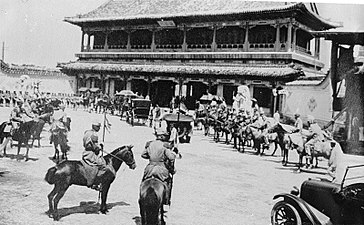

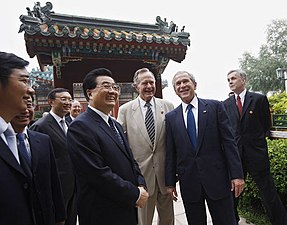

![Office buildings in the State Council area of Zhongnanhai[109]](https://upload.wikimedia.org/wikipedia/commons/thumb/4/47/Zhongnanhai04.jpg/193px-Zhongnanhai04.jpg)
